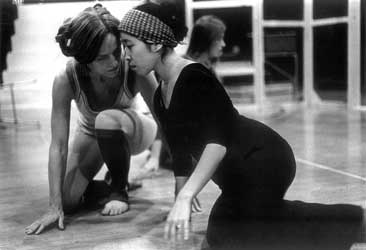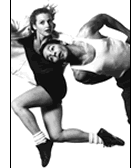|

Brenda Way and Kimi Okada in studio, 1976.
Photo by Doug Winter
Dance
Redefined
by Elizabeth Chur '92
Clad
in top hats and baggy coats, dancers march like hurried marionettes
under the commanding hands of a dictatorial puppeteer. Another performer’s
angular, pensive solo is followed by waltzing pairs staggering like
drunken bears, oblivious to her presence. All the performers then
fall repeatedly as if hurled, ricocheting like waves of hailing
basketballs. Finally, one dancer peels and eats a banana, the other
eight holding phantom bananas and mirroring his every swallow like
an animated Andy Warhol film. The evening’s work, titled Sauce
for the Goose, is a remounting of a piece that Associate Choreographer
Kimi Okada ’73 created in 1988. “It’s set in a vaudeville
atmosphere, but has an essentially dark core,” she says. “It’s
funny in the way that Beckett is funny.”
Over
the past 30 years, ODC/San Francisco dancers have rolled in bubble-wrap
suits, swung on platforms, and created a whimsical retelling of
The Velveteen Rabbit. Their dances are about the tension, exuberance,
and ambivalence of human relationships; isolation; the fragile balance
in the midst of random violence. The company’s trio of choreographers,
Artistic Director Brenda Way, Co-Artistic Director KT Nelson, and
Okada, met at Oberlin in the 1970s. During ODC’s evolution
they have become mothers (and in Way’s case, a grandmother)
and together have created more than 100 dances, a full-time dance
company of 10 men and women, a permanent home, and an artistic community.
Bringing back Sauce for the Goose was not so much a nostalgic impulse,
but a deepening of ODC’s continuing exploration of the uneasy
balance points between individual and group identities, explains
Way. Listening raptly is a sold-out audience of 200, including a
line of children sitting cross-legged on the floor in the front
row. “Sauce for the Goose still has a flavor and zest about
community,” Way says. “It’s one of my major passions—what
is community, and how are we in it? How do we identify with each
other, and how do we not identify with each other?”
The evening embodies so many of the values that form the through-lines
of ODC’s three-decade history: creating and expanding the circle
of community, hard work, and a spirit of unflagging joy. These values
are also what have kept ODC going for so long—“Longer
than most marriages!” as Way later jokes.
Okada offers a pre-performance lecture outlining a brief history
of postmodern dance: its rejection of technical training, dramatic
narrative, and emotional content, and its embrace of formalism and
structure. It has also stripped movement down to its essential elements,
rooting itself in everyday “pedestrian” motions like sleeping,
walking, waiting for a bus. “I can see you getting worried
that this piece is going to be really boring!” Okada laughs,
revealing to the audience the radiant expression she wore in photos
of ODC’s early days. Company dancers illustrate how a pedestrian
motion such as falling evolved through ever-more abstracted versions
(falling; falling in big, slow motion; two people falling in big,
slow motion) into the dance vocabulary of Sauce.
Much of ODC’s choreography starts from this interest in pedestrian
movement, using the discipline of a formalist approach to generate
raw material, but then incorporating narrative elements (albeit
often nonlinear), and animating them with dazzling technique and
a vigorous sense of humor. The San Francisco Examiner characterized
ODC’s style as “a return to what modern dancing is all
about—exuberant repertory…daredevil intensity and considerable
emotional candor."
View
Page 1 | 2
| 3 | 4
of Dance Redefined
|



